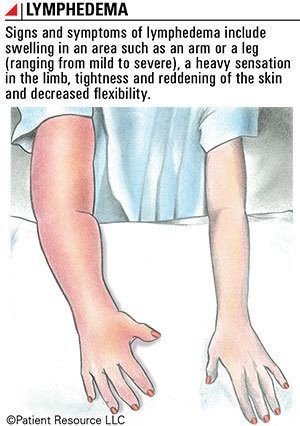Lymphoedema is a debilitating condition which has only been managed by massage and compression garments giving little hope to its suffers. That is until Macquarie University Hospital began using liposuction to treat advanced lymphoedema with promising results.
Cancer survivor Sharne Willoughby knows this all too well. After beating cervical cancer, the primary school teacher and mum of six, developed secondary lymphoedema.
What is lymphoedema?
 Lymphoedema is a condition which commonly occurs following lymph node removal or damage caused during the treatment of cancer, such as radiotherapy. The defect in the lymphatic system results in uncontrolled swelling of areas of the body, in particular the arms and legs.
Lymphoedema is a condition which commonly occurs following lymph node removal or damage caused during the treatment of cancer, such as radiotherapy. The defect in the lymphatic system results in uncontrolled swelling of areas of the body, in particular the arms and legs.
In a healthy person, fluid and proteins in the blood leak into the body tissues. This fluid acts to bathe cells, supply nutritional needs and receive back bi-products of their metabolism. The drainage of this tissue fluid occurs through the lymphatic system. When the lymphatic system is not functioning correctly, lymphoedema can occur.
Aside from swelling, symptoms of the condition can include heaviness of the affected areas, hot and tight feelings, painful joints, and aching sensations.
Over 300,000 Australians are affected by lymphoedema at any given time, and 20 percent of breast cancer survivors develop the condition. Both men and women who have had surgery and radiotherapy to treat cancers of the prostate, bowel or reproductive system, as in Ms Willoughby’s case, are also at risk of developing lymphoedema.
It’s debilitating on both a physical and emotional level
The current management of lymphoedema is through wearing compression garments, massage therapy, and exercise. Unable to receive regular treatment, Ms Willoughby’s condition continued to worsen over 10 years with her left leg weighing an incredible 12.5 kilograms more than her right.
As a result, she was unable to work full time, moving was difficult, and dressing normally was out of the question. Ms Willoughby tells The Sydney Morning Herald she wonders if she would be better off if her leg was amputated.
“There was absolutely nothing I did that wasn’t in some way impacted by the lymphoedema,” she said. “It was debilitating, both physically and emotionally. I felt so uncomfortable physically, and felt uncomfortable around other people.”
Upon being diagnosed with cervical cancer, the now 46-year-old, said she was focused on beating the disease. “It was a kick in the teeth to be told you’re going to be living with this chronic condition as a consequence,” she said. “I had a lot more information and support around cancer, that was really quite easy. But there’s nobody to talk to about your lymphoedema. GPs are quite dismissive. And because no one wants to show it, it’s quite a secret problem to have. People keep it hidden.”
Macquarie University Hospital’s Lymphoedema Program offers new hope
Lymphoedema can’t be cured and is commonly managed through physical therapy, compression bandage, exercises, massage and in some cases, medication. It’s aimed at managing the symptoms and helping patients cope with the condition.
Researchers and doctors at the Macquarie University Hospital are making inroads into the treatment of lymphoedema, and they’re gaining international attention in the process. By using liposuction, they hope to reduce the swelling, and increase the comfort of patient’s suffering from advanced lymphoedema.
Over 50 patients have taken part in the Lymphoedema Program undergoing liposuction as a way to remove excess fluid and tissue that has built up as a result of the malfunctioning lymphatic system.
Ms Willoughby is one of the liposuction recipients having undergone the treatment last year. The results speak for themselves. On the day of her surgery, she was unable to climb the eight stairs into the clinic. Just twelve weeks post op, she was climbing up the Sydney Harbour Bridge with plenty of reasons to celebrate.
In an interview with The Sydney Morning Herald she said she now feels she has her life back, and is able to work full time again and has since travelled overseas.
The Lymphoedema Program Director, Professor of Breast Oncology John Boyages, said liposuction surgery “changes people’s lives. It’s quite astonishing.” Through the program he’s seeing patients with constant pain, and together with the psychological impact and high financial costs of the condition, their life becomes “a misery”.
Liposuction surgery to treat lymphoedema
The liposuction surgery, as part of the Lymphoedema Program, aims to remove subcutaneous fat through small incisions along the affected limb, with the goal of reducing excess fatty tissue.
Following the treatment, there is a complete reduction of swelling, which reduces the pain and heaviness experienced. The patients also have an increased mobility as seen with Ms Willoughby’s ability to trek up the Sydney Harbour Bridge.
Custom-made compression garments are worn at all times post-surgery to ensure the results are maintained and the lymphoedema doesn’t reoccur. During follow up consultations, changes to the garment size occurs with the garment eventually adjusted to become the same size as the unaffected limb.
The liposuction surgery together with ongoing rehabilitation and compression therapy has resulted in patient’s affected limbs returning to their normal size within six months after having the surgery.
Liposuction surgery is giving new hope to sufferers like Ms Willoughby, who are crippled by this condition, both physically and emotionally. It’s an exciting development in the long-term treatment of lymphoedema.






